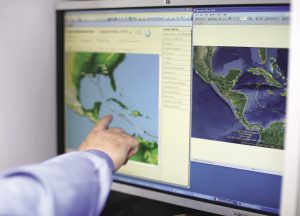In recent years the Cayman Islands have experienced extreme destruction from hurricanes so it is essential to be prepared for storms.
Hurricane Ivan devastated Grand Cayman in 2004, while Paloma wreaked havoc in Cayman Brac in 2008 and even tropical storms, and severe flooding from tropical waves, can have serious consequences.
While structural damage to buildings is often the primary concern when a weather system is approaching, it is essential to ensure that provision is made for health care during and after a storm.
There’s a possibility of being injured during a hurricane, but even if you get through it unscathed, the effects of a hurricane outside will create numerous opportunities for a variety of cuts, gashes, scrapes, punctures or sickness,
It’s easy to step on scattered nails or glass, to get cut by a sharp edge when clearing debris, or injure yourself when trying to conduct repairs to your home. Conditions after a hurricane can be unsanitary so it’s important to treat even the smallest wound.
Here are some key tips to stay healthy and to protect you and your family in the wake of a storm.
Assemble A First Aid Kit
Having a first aid kit – either one you buy or one you put together yourself – is vital, with the most important components being different-sized bandages, antibiotic ointment, gauze pads and adhesive tape. Also, have waterless alcohol-based hand sanitizer and anti-septic wipes in your kit.
Be sure to have at least a two-week – and preferably a full month – supply of any prescription medication as well as a supply of non-prescription pain relievers in your kit.
Have Plenty of Water On Hand
For health reasons, there is nothing more important than having fresh, clean water during and after a hurricane, with enough to supply each person with around one gallon per day.
City water is often turned off when the storm is approaching and, if infrastructure is damaged, can take days or even weeks to be restored.
It is a good idea therefore to make provision for a minimum of three days. This can be done by filling the bath tub and any other empty sterile containers with tap water and you can also stock up on shop-bought bottled supplies prior to the storm.
Once the supply is off, save all waste water from bathing and food preparation for flushing the toilets to ensure the bathroom is kept as hygienic as possible.
Stock Up On Non-Perishable Food
Stock up on canned food and dry goods in case your refrigerator goes off and shops are shut for a while after the storm. Store at least three days-worth of non-perishable food that requires no refrigeration, preparation or cooking, and little or no water. Ensure you have a manual can opener.
Try to stock food from each food group. Good proteins to stock include canned fish and chicken, which does not need cooking. High-energy foods will power you through both the storm and any hard labor in the aftermath.
Brush Up On Food Safety
If the power goes out, be wary of food kept in the fridge/freezer. Freezers, if left unopened and full, will hold their temperature for 48 hours (24 hours if half full). If the food still contains ice crystals, or is 40 F or below, it is safe to refreeze or cook. Refrigerated food should be safe as long as the power was out for no more than four hours. Discard any refrigerated perishable food such as meats and soft cheese after four hours without power.
Throw away food that may have come in contact with flood or storm water, perishable foods and those with an unusual odor, color or texture. This isn’t the time to guess or take a chance on something as you might under normal conditions. When in doubt, throw it out.
Red Cross Emergency App
The Red Cross Emergency app gives people instant access to weather alerts, life-saving information, and ways to contact family and friends in one free, easy-to-use app for mobile devices.
The app provides expert advice on what to do in case of disasters such as hurricanes, earthquakes and floods.
Important features include:
- Emergency first aid information for situations such as heart attacks, heat-related emergencies as well as water safety information.
- Preloaded content so users can access guidance from Red Cross experts even without mobile connectivity.
- Step by step directions on how to make a family emergency plan
Notify loved ones who are in an area affected by an emergency or disaster. The recipient can instantly see the alert details as well as specific “what to do now” steps, and then respond with either “I’m safe” or “I’m not safe.” This feature works even if the recipient has not downloaded the Emergency App.
The Emergency App is available from the Apple Store, Google Play or by visiting the Red Cross at redcross.org/apps.
Check out the Cayman Compass Hurricane Guide for more information on what to do before, during and after a storm.








